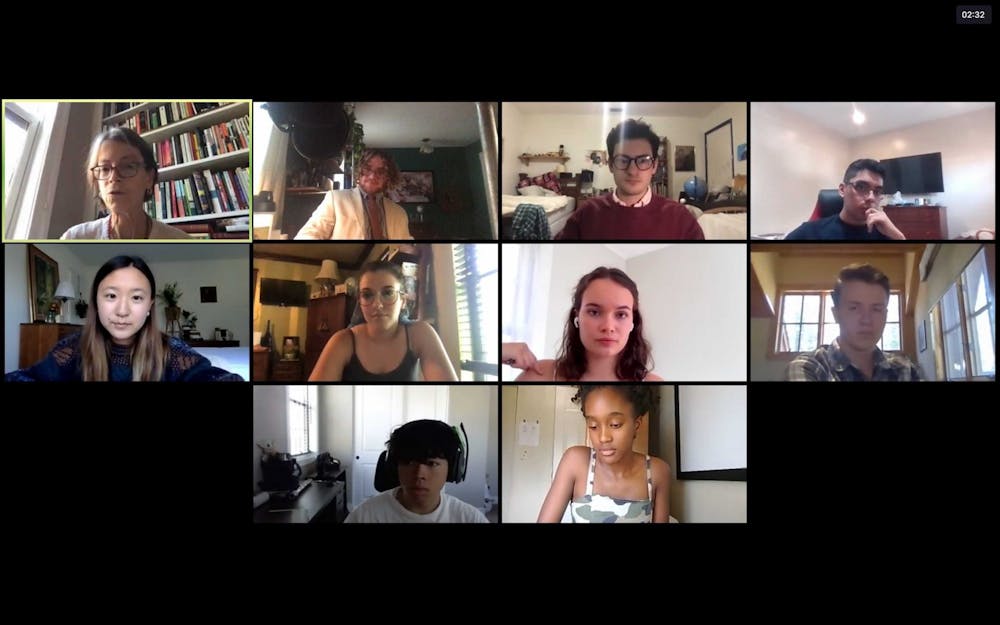The Humanities Sequence, also known as HUM, has taken hundreds of Princeton first-years from the hallowed heights of Homer’s Troy to the fiery depths of Dante’s hell. The course is well-known for its difficulty and rigor: 400 pages every week, 28 books in a semester.
More important to most students and professors, though, is the community around the course, the connections and camaraderie that grow after lectures and between precepts.
This semester, with students many miles from East Pyne Hall, students and professors are still considering how to create that community — a community that feels more necessary than ever in quarantine.
The disasters of 2020 force an interrogation of the course: How, in good faith, can we read ancient literature while the world crumbles around us? Do the humanities still have a purpose in a nation facing plague and a reckoning on race? Why should one pursue a course of study in the humanities, and not in public health or discrimination law?
The nature of the HUM sequence specifically, not just the larger discipline of the humanities, begs these questions. Of the 28 books on this fall’s syllabus, 26 were written by white men, and the other two were written by white women; amid calls for diversification of curriculum to reflect today’s world, HUM seems out of step.
This summer, HUM professors and students expressed their desire to see the course engage more fully with the current moment. As the first semester nears its close, professors and students considered what it means to be human and what the humanities still has to teach us in a moment of crisis.
Lectures, for one, may be better online. Current students Lara Katz ’24 and Mirae Choi ’24 enjoy pre-recorded lectures for the ability to stop, rewind, and speed up the lecture. Students can watch whenever they please, without having to lug themselves to the lecture hall three mornings a week. Even so, lectures still aren’t the same.
“There’s something you can’t convey through a screen,” Choi said.

The professors agree. Latin professor Yelena Baraz remarked on how online lectures feature less ad-libbing and more adherence to the plan. She described how small, non-verbal reactions from students during in-person lectures, a little nod or a knowing look, can drive a lecture in a new direction. But now these daily human interactions are lacking.
“[The lectures are] less live — they’re less alive,” Baraz said.
As for precepts, last semester they went “surprisingly well,” recalled Denis Feeney, Latin professor and coordinator of HUM this year. Despite this success, professors were wary of an entirely online course this semester.
“Frankly … most of the faculty were kind of dreading it,” said Feeney. “[We thought] ‘this is going to be very tough, because we’ve never met these students before.’ ” Perhaps unlike other courses, Feeney noted, HUM’s success is very largely reliant on the establishment of student and faculty relationships. Baraz echoed these worries. But things have gone far better than expected.

“The faculty in HUM have been really pleasantly surprised that it feels like a regular precept, to an amazing degree,” Feeney continued. “People are energized, people are really into it. I haven’t noticed any difference in preparation, how much people have read the texts.”
The students think so, too.
“I don’t feel like [precept] is that different than it would be if we were on campus,” Katz said. According to Katz, students still argue and augment each other’s interpretations of the texts — that much, at least, hasn’t changed.
And HUM students are still talking about the course outside of class, in group chats and FaceTime calls.
“The mini-discussions we have in the group chats signify that if we were on campus, we’d be talking about these [books] a lot,” Katz said.
But there is more to HUM than the lectures, precepts, and readings. Each year, a community grows up around the sequence. Feeney remembered the little knots of students who, after precepts, would sit under a tree and discuss Aeschylus or Homer. HUM students usually stick together after their two semesters, often taking more classes throughout the rest of their undergraduate career with their former HUM classmates.
The team of professors anticipated difficulty in creating this community and so added new features to bring students together.
On Wednesday mornings there are additional live meetings, outside of the three recorded lectures and Zoom precepts. These sessions are unstructured, a versatile time to augment the HUM curriculum: sessions thus far have covered how to write a paper, variances between different translations of the same text, and modern adaptations of ancient drama.
The class usually bleeds out beyond the classroom in ways that are now impossible. By this point in the semester, the group would have traveled together to New York to see a play and would have toured the University Art Museum. The fall after the sequence, the class takes a trip to Athens and Rome; last year’s group has already missed out on this trip, and this year’s chances hang in the balance. So with lectures remote and all trips impossible, Wednesday mornings are the only time when all the students in the class come together.
As for diversity and inclusion in the classroom, the professors have pushed to institutionalize and standardize conversations surrounding race, gender, and sexuality, making these topics more central to the HUM experience. Benjamin Morison, philosophy professor and HUM lecturer, along with former HUM professor Beatrice Kitzinger, are running optional meetings every other Thursday evening to discuss social justice in the readings for the sequence.
These meetings are informal and serve as a space to discuss the misogyny, racism, and sexual violence that festers in much of the reading list. In previous years, students regularly met informally to discuss these issues; this year, Morison and Kitzinger made them an organized forum.
“We were just hopping on the bandwagon of the students who had started,” Morison said.
While addressing the inherent lack of diversity in the HUM sequence, these Thursday meetings also serve as an additional time to come together. Morison and Kitzinger intentionally organized the breakout rooms to be cross-precept, to give students one more place to talk together in this extraordinary semester.
Morison found it important to discuss the racial and social implications of HUM texts, especially in a moment of racial reckoning in the United States. But even while putting the course under scrutiny, moments of crisis and change — like 2020 — often drive students away from the humanities.
If a pandemic can kill more than 200,000 Americans, and New York can be underwater in 50 years, and a free American can die facedown on the street underneath a police officer’s knee, to spend one’s days in an ivory tower reading Ovid can feel like a pernicious luxury. But, per HUM’s professors, we still need the humanities.
“It’s not just science that’s having an effect on how the pandemic is proceeding,” Baraz said. “It’s what people think they owe to each other; it’s what they think their responsibilities are; it’s what they think is moral; it’s what they think is right. That’s having as much of an effect on the way the pandemic has hit us as the virus is.”
“That’s what the humanities is best at,” Morison said.
“Telling us how to be human.”








